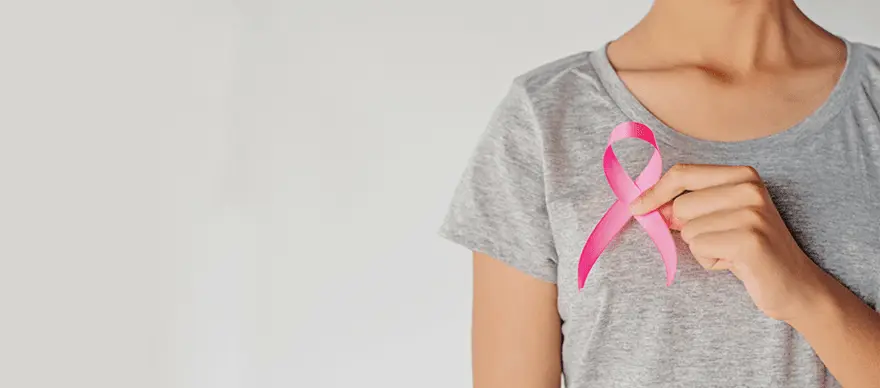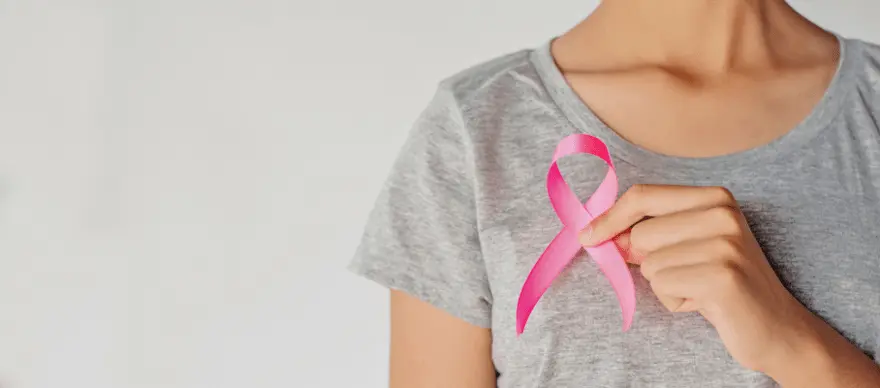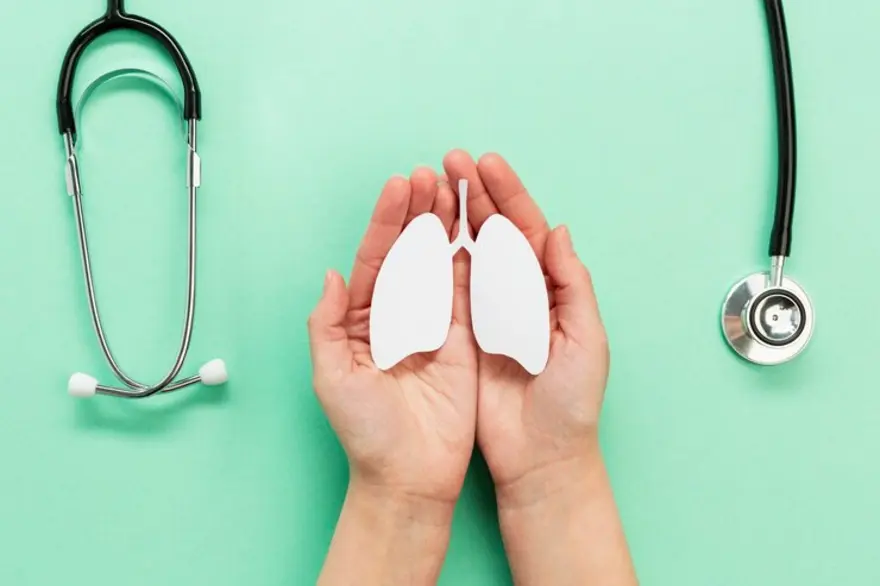breast cancer test
Breast Cancer: Early Warning Signs You Must be Aware of
Breast cancer happens to be the most common cancer among women globally. Though it may affect both men and women, breast cancer is more common in women. According to the epidemiological studies, the global burden of BC is expected to cross almost 2 million by the year 2030[2]. Even in India, the newly reported cases of breast cancer have significantly increased. Despite multiple campaigns and efforts by the Government and private organizations, the awareness around breast cancer remains low, especially in sub-urban and rural India. It is critical to understand that cancer can be defeated if diagnosed at early stages. Take a look at some of the early symptoms of breast cancer Mutations in BRCA1 and BRCA2 genes are associated with breast cancer. A BRCA 1 and 2 profile test is ordered in Individuals with a strong history of breast or ovarian cancer. Early Symptoms of Breast Cancer: The most common symptoms of breast cancer include: Changes on breast skin, such as swelling, redness, or other visible differences in one or both breasts A lump or a mass or nodes felt on or inside of the breast or armpit An increase in size or change in shape of the breast(s) (not linked with puberty in young girls) Discharge other than breast milk from nipples Pain or ulceration in/on any part of the breast Inward pulling of the nipple or pain in the nipple area Not all women with breast cancer experience the same symptoms. They can vary to some extent from person to person. A study has reported that women aging above 40 with high cholesterol were 45% less likely to develop breast cancer than those without high cholesterol. Track your cholesterol levels from time to time. Early Detection Saves Lives It is common for women to ignore a doctor visit owing to the privacy concerns and stigmas associated. Do not hesitate to consult a doctor if you notice any early warning sign. What Can Put You at Risk of Breast Cancer? Risk factors that cannot be changed (non-modifiable risk factors) Advancing age: Most breast cancers are diagnosed after age 50. The risk for breast cancer increases as a woman gets older. Reproductive history: If a woman got periods before age 12 and had menopause after age 55, this exposes her to hormones for a longer period, that can increase the risk of getting breast cancer. Dense breasts: Women with dense breasts are more likely to get breast cancer. Family history of breast or ovarian cancer: The risk of getting breast cancer for a woman goes up if her first-degree relative (mother, sister, or daughter) has breast or ovarian cancer. Risk Factors that can be controlled (modifiable risk factors) Sedentary lifestyle: Women who are not physically active have a higher chance of getting breast cancer. Being overweight: Unhealthy weight or obesity increases women's risk of getting breast cancer than those who have maintained a normal weight. Reproductive history: Having the first pregnancy after age 30 and not breastfeeding can raise breast cancer risk. Alcohol consumption and smoking: Several studies have shown that drinking alcohol and/ or smoking increase a woman’s risk for breast cancer. Tips to Cut Down The Risk of Breast Cancer Get involved in physical activity. Exercise regularly Maintain a healthy weight Limit alcoholic drinks and quit smoking, one step at a time If you have a family history of breast cancer or inherited changes in your BRCA1 and BRCA2 genes, talk to your doctor about other ways to lower your risk. A simple habit to keep yourself safe from breast cancer A breast self-exam is a simple check-up which women can do at home to look for changes or problems in their breast. This method requires a woman to look at herself and feel each breast for possible lumps, distortions or swelling. Here is How You Can Perform Self-Breast Examination: Step 1 Undress from the waist up and stand straight with your hands on your waist in front of a large mirror in a well lighted room. Take your time and observe your breasts. Look for any changes in shape, size or position, or any change in skin around it. Check if there is any puckering, dimpling, sores or discoloration. they might not be equal in size or shape and that’s perfectly okay. If you notice any change, bulging of the skin, visible distortion or swelling, you should bring it to the notice of your doctor. Check your nipples, examine them carefully for any sores, peeling or change in their direction- a nipple that has changed position or has redness, rash or swelling. Step 2 Raise your arms high and look for the same changes in the mirror. See if there is any sign of fluid coming out of any nipple, it can be watery, milky or yellowish fluid or even blood. Step 3 Lie down on a bed and then touch your left breast with your right hand and vice versa. With the fingertip pads of your hand check your breast using a firm smooth circular motion. Examine the entire breast from top to bottom, side to side- from your collar bone to the top of your abdomen, from your armpit to your cleavage. Follow a pattern so as to cover the whole breast area. Start from the nipple, moving in larger and larger circles until you reach the outer edge of the breast. Or as more women prefer, you can also move your finger pads up and down vertically, in rows like while you are mowing a lawn. Be sure to check all the tissues from the front to the back of your breast Step 4 Feel your breasts while standing or sitting. Cover your entire breast, using the same movements described in the previous step. Do not panic if you feel a lump or something unusual while you are self-examining yourself. There can be a number of causes behind the changes, not just cancer. It might be due to hormonal changes, a benign breast condition or an injury. Consult a doctor and clear any doubts. Breast Cancer Screening One should not depend only on self-exam to rule out cancer. No single test can detect all breast cancer early but breast cancer organizations believe that performing a breast self-exam along with other screening methods can increase the odds of early detection. Regular physical examination by a doctor, mammography and if necessary ultrasound or MRI; all or any might be needed. Apart from breast self-examination, certain imaging tests can help learn more about your breasts and detect any disease even before it gives symptoms: Mammogram. This detailed X-ray gives doctors a better view of lumps and other problems. Magnetic resonance imaging (MRI). This body scan helps create detailed images of the insides of your breasts. Biopsy. For this test, the doctor removes tissue or fluid from your breast and looks at it under a microscope to check for cancer cells and, if they’re there, learn which type they are. Common procedures include: Fine-needle aspiration Core-needle biopsy Surgical (open) biopsy Lymph node biopsy Image-guided biopsy Remember, breast cancer can be treated. The key to treatment is early detection and timely adequate care. Just take care of yourself and stay aware of warning signs.
When Should You Get a Mammogram for Breast Examination
What is a mammogram? A mammogram is an X-ray of the breast used by doctors as a screening tool for breast cancer and to detect abnormalities in breast tissue. A mammogram is considered a useful test to identify breast cancer early, even before symptoms develop. In a few cases up to three years before they can be felt or detected. This is called a screening mammogram. While a diagnostic mammogram is advised by a healthcare professional in case you develop any new symptom, such as a lump, pain, nipple discharge or breast skin changes. Breast cancer is the most prevalent cancer worldwide and is one of the leading causes of death in women. Although treatment approaches for breast cancer continue to improve, early diagnosis with the help of screening mammograms has significantly reduced the cancer-related deaths and impacted the survival rates of these patients. Please note that not all breast lumps are breast cancers. Your doctor can ask for specific tests to differentiate between a cancerous and a noncancerous mass. Why is a screening mammogram different from a diagnostic mammogram? A screening mammogram is a routine, in most cases done annually to check for signs of breast tissue abnormalities before you have symptoms. It typically includes at least two pictures of each breast taken at different angles, from top to bottom and from side to side. However, you can undergo a diagnostic mammogram if your screening mammogram detects an abnormal tissue in your breast. It includes extra views and utilizes additional imaging techniques which are supervised by the radiologist at the time of the study. Who all should undergo a mammogram? Various organizations such as American College of Obstetricians and the American College of Radiology, recommend an annual screening mammogram, starting at age of 40 years for all women with an average risk of developing breast cancer. The American Cancer Society recommends the following: Women with age 40 to 44 years should have the option to start annual breast cancer screening with mammograms. Women with age 45 to 54 years should undergo mammograms every year. Women who are 55 and older can choose to get mammograms every 2 years, or can continue yearly screening. Screening mammograms should be continued if a woman is in good health and is expected to live 10 more years or longer. All women should be aware with the benefits, limitations, and potential harms associated with breast cancer screening. Occasionally, males who are at high-risk of developing breast cancer because of their family history may also get screening mammography. However, about 1 out of 100 males develop breast cancer. Besides, your healthcare provider may ask you to take annual screening mammograms if you have any of the following risk factors: Family history of breast or ovarian cancer Personal history of breast cancer Inherited genetic mutations Certain noncancerous breast diseases such as atypical ductal hyperplasia or lobular neoplasia Dense breasts. How is a mammogram done? A mammogram is a special X-ray designed to check only breast tissues. You will stand in front of the machine and a technician will place your breast on a plastic plate Another plate, known as paddle will firmly press your breast from above which will flatten it, you might feel some pressure at this moment These two plates will hold the breast still while the X-ray is being taken The machine creates X-rays that pass through your breast to a detector located on the opposite side The detector transmits electronic signals to a computer to form a digital image These steps are repeated to capture side views of the breast for both breasts. How can you prepare yourself for a mammogram? Although getting a mammogram is not usually an uncomfortable procedure for most women, it takes only a few moments and any discomfort, if present gets over soon. You will be required to remove all clothing and jewellery from your waist up for the imaging procedure. Points to consider while scheduling your appointment for mammogram: If you have been recently vaccinated for COVID-19, and are due for a mammogram, ask your healthcare provider for how long you should wait after vaccination to get your mammogram done Avoid scheduling your mammogram the week before you get your period or during your period as your breasts may be tender during this time, which could make it uncomfortable Try to inform your doctor if you are breastfeeding, pregnant or suspected to be pregnant If you have breast implants, do not forget to mention it to your healthcare provider. There are certain guidelines that you are required to follow on the day of your mammogram: Follow your normal routine including regular medicines You should remember to not apply the following substances as they can appear as white spots on the image and will interfere with the accuracy of mammogram: Deodorants Body powders Perfumes Ointments or creams on your breasts or underarms. How safe are mammograms? Although mammograms expose your breasts to small amounts of radiation, its benefits outweigh any potential harm from the radiation exposure. Do you feel pain during mammograms? A mammogram experience can be different for different people. The level of discomfort that you feel depends on the following factors, such as: The size and density of your breasts The compression your breasts need while capturing the image If you are having or about to get on your period as your breasts may be more tender and sensitive to compression The skill of the radiology technician You will feel less discomfort if you are relaxed and position yourself in the best way for good images. What does the result of mammogram signify? If your mammogram is normal, continue to get mammograms according to recommended time intervals. Screening mammograms are most beneficial when a radiologist can compare them to your previous mammograms to analyse the changes in your breasts. If your mammogram is abnormal, and shows one or more suspicious regions, it does not necessarily mean that you have cancer. You will be advised to undergo additional mammogram views, other imaging tests including a breast ultrasound, or a breast biopsy. In nutshell, mammography is a fast and safe procedure. A mammogram can save your life as early detection of breast cancer reduces your risk of dying from the disease by 25-30% or more. Consult your doctor about your need for mammograms, so you can make sure to start screening as early as possible. When did you have your last health check up? Book one now.
 Home Visit
Home Visit Upload
Upload
















 WhatsApp
WhatsApp